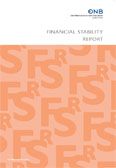Financial Stability Report 15
 OeNB
OeNB
- published:
- June 2008.
 OeNB
OeNB
Financial Stability Report 15 (PDF, 7.1 MB) June 2008.
Austria’s Financial System Faces Difficult Conditions (PDF, 42 kB) Financial Stability Report 15 en Jun 15, 2008, 12:00:00 AM
Continued Financial Turmoil Dampens Global Economic Outlook (PDF, 367 kB) Financial Stability Report 15 en Jun 15, 2008, 12:00:00 AM
Financing Conditions Have Tightened for the Real Economy Sectors
(PDF, 199 kB)
Financial Stability Report 15_x000D_
en
Jun 15, 2008, 12:00:00 AM
Austrian Financial Intermediaries Perform Well despite Financial Market Turbulence (PDF, 375 kB) Financial Stability Report 15 en Jun 15, 2008, 12:00:00 AM
Stress Tests for the Austrian FSAP Update 2007: Methodology, Scenarios and Results (PDF, 296 kB) Boss, Fenz, Krenn, Pann, Puhr, Scheiber, Schmitz, Schneider, Ubl. Boss, Fenz, Krenn, Pann, Puhr, Scheiber, Schmitz, Schneider, Ubl – Financial Stability Report 15 This paper presents the methodology, scenarios and results of the stress tests conducted for the update of Austria’s Financial Sector Assessment Program (FSAP) in 2007. The focus of the paper lies in particular on the following two macroeconomic stress scenarios: (a) a regional shock in Central, Eastern and Southeastern Europe hitting Austrian banks through their large exposure in the region, and (b) a global downturn in economic activity causing a deterioration of Austrian banks’ domestic loan portfolios, whereby in the second scenario, contagion risk within the Austrian interbank market was also taken into account. Stress test calculations were performed by the OeNB for all Austrian banks (top-down approach) as well as by the six largest Austrian banking groups for their respective exposure (bottom-up approach). The paper describes the methodologies for scenario construction and the stress tests themselves and then discusses the scenarios as well as the stress test results in detail, including a comparison of the two approaches. Finally, the paper presents the results of additional sensitivity stress tests for credit risk emanating from foreign currency lending, for the most important categories of market risk and for liquidity risk. Overall, the update of Austria’s FSAP 2007 confirmed the results of previous stress testing exercises, in particular for the large Austrian banking groups that show considerable shock resistance mainly as a result of their generally sound capital buffers and high profitability. en Financial stability, stress testing, FSAP G10, G21, F23 Jun 15, 2008, 12:00:00 AM
Systemically Important Accounts, Network Topology and Contagion in ARTIS (PDF, 5.1 MB) Boss, Krenn, Metz, Puhr, Schmitz. Boss, Krenn, Metz, Puhr, Schmitz – Financial Stability Report 15 This study investigates the relevance of network topology for the stability of payment systems in the face of operational shocks. The analysis is based on a large number of simulations of the Austrian large-value payment system ARTIS that quantify the contagion impact of operational shocks at participants’ sites. It uncovers that only few accounts are systemically important. We also find that network indicators at the node level can have some explanatory power, which is higher when the analysis focuses on contagion measured by the number of banks with unsettled payments than on that measured by the value of unsettled payments. The explanatory power is, however, lower than that of the more traditional measures of node activity(value and volume) of payments. At this stage of our research, network indicators at the network level seem to be of limited use for stability analysis. en Operational risk, payment systems, network topology, stress tests E50, G10 Jun 15, 2008, 12:00:00 AM
Is Current Capital Regulation Based on Conservative Risk Assessment? (PDF, 206 kB) Breuer, Jandacka, Rheinberger, Summer. Breuer, Janda?ka, Rheinberger, Summer – Financial Stability Report 15 We criticize the popular view that separately calculating regulatory capital for market and credit risk yields a conservative aggregate risk assessment. We show that this view depends on a flawed intuition about diversification effects that arise between subportfolios. If a bank’s portfolio cannot be neatly divided into two subportfolios along the lines of market and credit risk, simply adding up the respective results may cause the true portfolio risk to be underestimated. Using the example of foreign currency loan portfolios, we show that this underestimation can be quantitatively significant. en Integrated analysis of market and credit risk, risk management, foreign currency loans, banking regulation. G28, G32, G20, C15 Jun 15, 2008, 12:00:00 AM
Walking the Tightrope: A First Glance on the Impact of the Recent Global Financial Market Turbulence on Central, Eastern and Southeastern Europe (PDF, 582 kB) Gardó, Hildebrandt, Walko. Gardó, Hildebrandt, Walko – Financial Stability Report 15 The Central, Eastern and Southeastern European (CESEE) countries have, to some extent, felt the impact of the international financial market turbulence observed since July 2007. While CESEE markets tended to follow the negative global investor sentiment in general, they performed relatively well compared to other emerging markets. Overall, increases in risk premiums and asset price losses were rather contained in the region, which may reflect a positive impact on investor judgment induced by EU convergence. However, the fact that the financial turmoil had a stronger impact on countries with weaker economic fundamentals and/or insufficient policy credibility shows that correcting overly large economic imbalances remains imperative in a relatively fragile international environment. en Financial markets; economic vulnerabilities; Central, Eastern and Southeastern Europe; CESEE G15, O16, O52 Jun 15, 2008, 12:00:00 AM
Annex of Tables (PDF, 199 kB) Financial Stability Report 15 en Jun 15, 2008, 12:00:00 AM